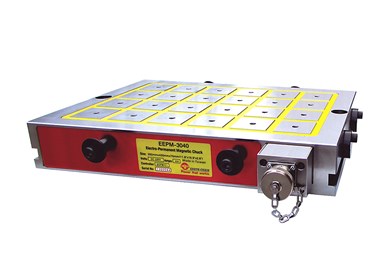Magnetic Workholding Chucks for Increased Holding Force
IMTS 2022: The workholding chucks are designed to enable more companies to realize the benefits of magnetic workholding by addressing a wider range of applications.

Photo Credit: Techniks
Techniks’ line of EEPM electropermanent magnetic workholding chucks includes the EEPM-D series featuring 70 mm poles for increased holding force for large workpieces and parts with significant airgaps. The EEPM-A series features 35 mm poles for improved holding forces for smaller and thinner workpieces. Both the EEPM-D and EEPM-A series are available in 9 sizes. The company says these series will enable more companies to realize the benefits of magnetic workholding by addressing a wider range of applications.
These chucks are said to require only a few seconds of power to activate and deactivate. When activated, the power cord may be removed from the chuck. The chucks will not lose holding power when the power cord is disconnected. EEPM chucks feature a quad-pole design that creates strong holding forces of up to 6,000 lbs of holding force for every 4 poles, which is said to make them suitable for high material removal rates.
Because the workpieces are held with magnetic flux, 5-sided machining is possible without obstructions of vice jaws. The use of induction riser blocks enables access to the bottom sides of workpieces and for through-hole machining. Spring-loaded induction riser blocks enable machining in a free state without the compressive forces on the workpiece associated with traditional mechanical clamping.
Multiple workpieces may be ganged on EEPM chucks to utilize the CNC machine’s work envelope more fully. The use of sub-plates machined with the profile of the workpieces permits fast workpiece changeover and job change-out times. EEPM chucks are a perfect solution for both vertical and horizontal setups.
Related Content
-
The Value of Swiss-Types Milling Rectangular Medical Parts
High-speed spindle technology was key to effective milling of small cardiac monitoring components complete on a CNC sliding-headstock machine platform instead of running them across two mills.
-
Increased Competition Calls for Smarter Solutions
Engineered for efficiency, SW Machines offers customers a full suite of horizontal machining centers and the automation needed for high-volume, high-precision manufacturing.
-
German Project Yields Three New Medical Machining Processes
Recent research has resulted in a new mix of high-speed turn whirl milling, polygon turning and rotational turning for manufacturing medical bone screws and out-of-round nails.












